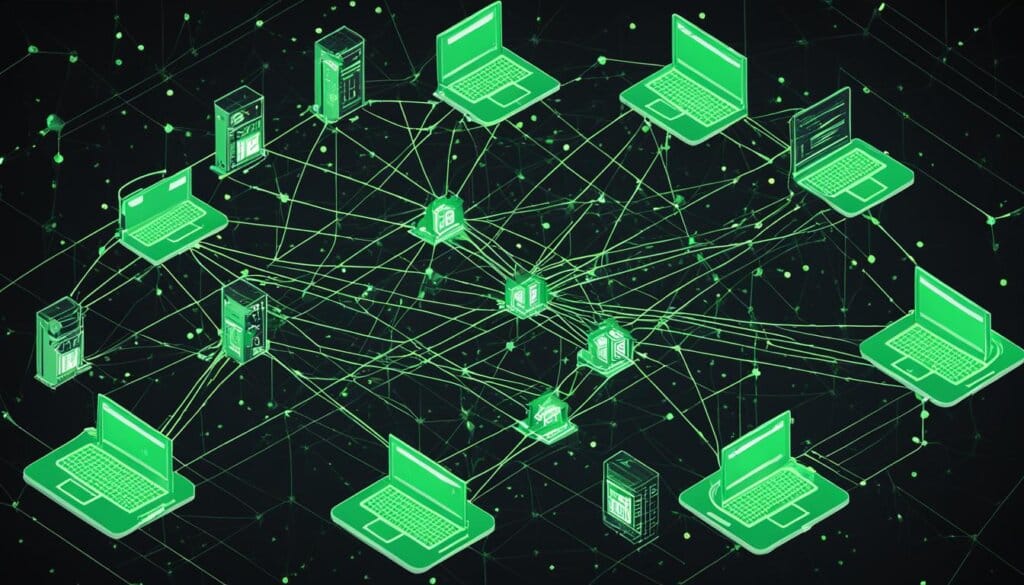Table of Contents
The Transmission Control Protocol (TCP) is a fundamental internet protocol that plays a crucial role in network communication and data transfer. It is part of the TCP/IP suite, which stands for Transmission Control Protocol/Internet Protocol.
TCP/IP is a set of protocols used to connect network devices, both within a private network and over the internet. TCP/IP serves as an abstraction layer between applications and the routing and switching fabric of a network. It specifies how data should be exchanged by breaking it into packets, addressing it, transmitting it, routing it, and ensuring its reliable delivery at the destination.
TCP, one of the main protocols in the suite, is responsible for creating communication channels across a network, dividing messages into smaller packets, and reassembling them in the correct order. IP, the other main protocol, defines how to address and route each packet to the intended destination.
TCP/IP is highly scalable, compatible with all operating systems and computer hardware, and is widely used in internet architecture.
Next, let’s explore the four layers of the TCP/IP model and how TCP differs from UDP.
The Four Layers of the TCP/IP Model
The TCP/IP model is a framework that facilitates the transmission of data across networks. It consists of four distinct layers, each serving a specific purpose in the data transmission process.
- Application Layer: This layer functions as the interface between the network and the applications running on a device. It enables applications to access network services and provides protocols such as HTTP, FTP, and SMTP.
- Transport Layer: The transport layer is responsible for the reliable delivery of data between devices. It ensures that the data is broken down into smaller segments, appropriately addressed, and reassembled at the destination. The main protocols in this layer are TCP and UDP.
- Internet Layer: The internet layer handles the routing of data packets across different networks. It takes care of addressing and forwarding packets from the source device to the destination device using protocols like IP.
- Physical Layer: The physical layer provides the physical connectivity between network devices. It deals with the transmission and reception of raw data bits over physical media such as cables and wireless signals.
The TCP/IP model’s layered structure allows for a modular approach to network communication, enabling each layer to focus on its specific set of tasks. This division of responsibilities helps in the efficient transmission of data and contributes to the overall reliability and scalability of the TCP/IP suite.
| Layer | Function | Protocols |
|---|---|---|
| Application Layer | Interface between applications and the network | HTTP, FTP, SMTP, DNS |
| Transport Layer | Reliable data delivery between devices | TCP, UDP |
| Internet Layer | Routing and addressing of data packets | IP, ICMP, ARP |
| Physical Layer | Physical connectivity between devices | Ethernet, Wi-Fi, DSL |
TCP vs. UDP: Understanding the Differences
When it comes to transmitting data over the internet, two commonly used protocols are Transmission Control Protocol (TCP) and User Datagram Protocol (UDP). While both protocols serve the purpose of data transmission, they have significant differences in terms of their characteristics and use cases.
TCP (Transmission Control Protocol)
TCP is a connection-oriented protocol that provides reliable delivery of data. It guarantees that data packets arrive at the destination in the correct order and without any errors. TCP achieves this reliability through various mechanisms, such as error detection and correction, flow control, and congestion control.
TCP establishes a connection between the sender and the receiver before transmitting any data. This connection allows for the establishment of a virtual circuit between the two endpoints, ensuring that data is transmitted in a sequential and organized manner.
UDP (User Datagram Protocol)
Unlike TCP, UDP is a connectionless communication protocol. It does not establish a dedicated connection before transmitting data. Instead, UDP simply sends data packets without any acknowledgment or error-checking mechanisms. As a result, UDP offers faster transmission speeds but does not guarantee data reliability.
UDP is commonly used in scenarios where real-time communication or low-latency is essential. For example, multimedia streaming, online gaming, and VoIP (Voice over Internet Protocol) applications often rely on UDP for their high-speed and low-latency requirements.
Comparison Table: TCP vs. UDP
| TCP | UDP |
|---|---|
| Connection-oriented | Connectionless |
| Reliable data delivery | Unreliable data delivery |
| Guarantees data integrity | No guarantee of data integrity |
| Order preservation of data packets | No order preservation of data packets |
| Provides flow control and congestion control | No flow control or congestion control |
| Higher latency due to reliability mechanisms | Lower latency due to absence of reliability mechanisms |
Note: The table above summarizes the key differences between TCP and UDP.
Understanding the differences between TCP and UDP is crucial for choosing the appropriate protocol based on the specific requirements of a given application. While TCP ensures reliable and orderly data transmission, UDP offers speed and low-latency advantages for real-time applications where occasional data loss is acceptable.
How TCP Works in Data Transmission
TCP (Transmission Control Protocol) is a connection-oriented protocol used to establish and maintain a reliable connection between applications or devices for seamless data transmission. It follows a three-way handshake process to ensure a stable and secure connection.
- Syn: The communication starts with the client sending a SYN (synchronize) packet to the server. This packet includes the initial sequence number, which helps in organizing data packets and ensuring their correct order.
- Syn-Ack: Upon receiving the SYN packet, the server responds with a SYN-ACK (synchronize-acknowledge) packet. This packet acknowledges the request from the client and contains the server’s own initial sequence number.
- Ack: In response to the SYN-ACK packet, the client sends an ACK (acknowledge) packet to the server, confirming the successful connection establishment. The client’s acknowledgment packet also includes acknowledgment of the server’s initial sequence number.
Once the three-way handshake is complete, the TCP connection is established, and data transmission can begin. TCP divides data into smaller units called packets. These packets include headers that contain important information such as the sequence number, acknowledgment number, and control bits for flow control and error detection.
TCP uses flow control mechanisms to regulate the rate at which data is sent and received, ensuring that the receiving device can handle the incoming data without overload. It also implements error detection and correction techniques to guarantee data integrity.
“TCP provides reliable, ordered, and error-checked delivery of a stream of octets between applications running on hosts communicating via an IP network.” – RFC 793
| TCP Data Transmission | Connection-Oriented Protocol | Three-Way Handshake | Packets | Flow Control | Error Detection and Correction |
|---|---|---|---|---|---|
| Transmission of data in a structured format over a network using TCP. | Establishes and maintains a reliable connection between applications or devices. | Three-step process to establish a TCP connection between a client and a server. | Smaller units in which data is divided for efficient transmission. | Mechanisms to regulate the rate of data flow for optimal performance. | Techniques to detect and correct errors in the transmitted data. |

By implementing these mechanisms, TCP ensures that data is transmitted accurately and efficiently across a network, making it a reliable protocol for various applications such as web browsing, file transfer, email delivery, and more.
Use Cases of TCP/IP
TCP/IP is a versatile protocol suite widely used for various applications and services in network communication. Its robustness, reliability, and scalability make it ideal for numerous use cases. Some common use cases of TCP/IP include:
- Remote Login: TCP/IP enables secure remote login to access computers and servers remotely. It allows users to log in and manage systems from different locations, facilitating efficient remote administration and troubleshooting.
- File Transfer: TCP/IP is essential for transferring files over the internet or within a network. It ensures the reliable and secure delivery of files, making it commonly used in FTP (File Transfer Protocol) and SFTP (Secure File Transfer Protocol) applications.
- Email Delivery: TCP/IP plays a critical role in email delivery. It ensures that emails are sent and received reliably by breaking them into packets, managing the flow of data, and providing error detection and correction mechanisms.
- Web Browsing: TCP/IP is the foundation of web browsing. It allows users to access websites, retrieve web pages, and communicate with web servers through protocols like HTTP (Hypertext Transfer Protocol) and HTTPS (Hypertext Transfer Protocol Secure).
- Database Access: TCP/IP facilitates secure and reliable access to databases over a network. It enables efficient querying, retrieval, and modification of data, making it essential for applications that rely on databases.
- Remote Access: TCP/IP enables remote access to devices and systems, making it possible to control and manage them from a different location. This functionality is crucial for remote troubleshooting, system administration, and remote support services.
- Messaging: TCP/IP supports various messaging applications, including instant messaging, chat services, and collaboration tools. It ensures the seamless transmission of messages between users, enabling real-time communication.
With TCP/IP’s versatility and reliability, it continues to power critical network communication across a wide range of industries and applications.
Advantages and Disadvantages of TCP
TCP, as a protocol for network communication, offers several advantages and disadvantages that should be considered in various scenarios.
One of the key advantages of TCP is reliable data transfer. TCP ensures that data packets sent across a network are delivered accurately and in the correct order. This reliability is achieved through mechanisms such as sequence numbers, acknowledgments, and retransmissions, guaranteeing the integrity of the transmitted data.
Furthermore, TCP is highly scalable, allowing it to handle a large number of connections simultaneously. This scalability makes TCP suitable for applications that require concurrent connections, such as web servers or file transfer services.
However, TCP does have some disadvantages. One of the main concerns is the complexity of the protocol. TCP’s robustness and reliability come at the cost of increased complexity, which can make its implementation and management more challenging.
Another drawback is the overhead TCP introduces. The additional overhead, including header information and acknowledgment mechanisms, can impact network performance, particularly in environments with limited bandwidth or high network congestion.
Overall, TCP’s advantages, such as reliable data transfer and scalability, make it a suitable choice for many network communication scenarios. However, the complexity and overhead associated with TCP should be carefully considered depending on the specific requirements of the application or network infrastructure.
FAQ
What is TCP?
TCP stands for Transmission Control Protocol, which is a fundamental internet protocol that plays a crucial role in network communication and data transfer.
What is TCP/IP?
TCP/IP is a set of protocols used to connect network devices, both within a private network and over the internet. It stands for Transmission Control Protocol/Internet Protocol.
How does TCP/IP work?
TCP/IP serves as an abstraction layer between applications and the routing and switching fabric of a network. It specifies how data should be exchanged by breaking it into packets, addressing it, transmitting it, routing it, and ensuring its reliable delivery at the destination.
What are the layers in the TCP/IP model?
The TCP/IP model consists of four layers, namely the application layer, transport layer, internet layer, and physical layer. Each layer is responsible for specific protocols and functions in the data transmission process.
What are the differences between TCP and UDP?
TCP is a connection-oriented protocol that establishes and maintains a connection between applications or devices until data transmission is complete. UDP, on the other hand, is a connectionless protocol that does not guarantee reliable delivery of data and is known for its low latency and higher data transfer speeds.
How does TCP work in data transmission?
TCP works by employing a three-way handshake to establish a connection, dividing messages into smaller packets, ensuring flow control, and providing error detection and correction mechanisms.
What are some use cases of TCP/IP?
TCP/IP is widely used for remote login, file transfer, email delivery, web browsing, database access, remote access, and messaging.
What are the advantages and disadvantages of TCP?
TCP offers reliable data transfer, scalability, and compatibility with all operating systems and computer hardware. However, it can be more complex and has higher overhead compared to other protocols.












